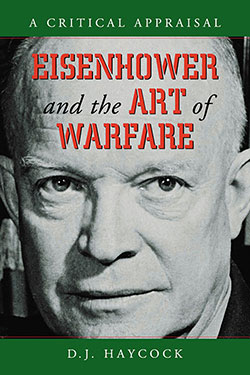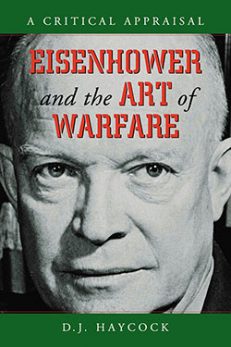Eisenhower and the Art of Warfare
A Critical Appraisal
Original price was: $29.95.$23.99Current price is: $23.99.
In stock
About the Book
On August 14, 1942, Chief of Staff George C. Marshall appointed General Dwight D. Eisenhower Commander of the European theater of operations for North Africa. Eisenhower had no prior training or experience in warfare and no experience commanding an army. Frequently, he was subjected to unjustifiable interference from Marshall (who was 3,000 miles away from the fighting). This book explores the idea that both Eisenhower and Marshall made too many decisions which were based not on sound military principles, but rather on nationalism and well-intended generosity. Beginning with his appointment and the planning of the invasion of North Africa (codename “TORCH”), this work suggests that Eisenhower’s involvement in political situations weakened his effectiveness on the battlefield. One chapter focuses on the poorly organized Allied air command in Algeria and discusses Eisenhower’s reluctance to be part of a unified air command. Another records his appointment to the position of Supreme Allied Commander North African Theater of Operations, and also explores Eisenhower’s inconsistencies and indecisiveness during the planning of the invasion of Sicily. Chapter Seven covers the much-disputed “DRAGOON” operation—the invasion of Southern France to the detriment of the Italian campaign—and Eisenhower’s insistence on “broad front” warfare and resistance to the idea of indirect attack. Much of the book provides detailed insight into the rationale—both sound and questionable—that was behind many of the strategic decisions made by Eisenhower during World War II and suggests that with more experienced leadership, the conclusion could have come much sooner and with fewer casualties.
About the Author(s)
Bibliographic Details
D.J. Haycock
Format: softcover (6 x 9)
Pages: 239
Bibliographic Info: photos, maps, notes, bibliography, index
Copyright Date: 2004
pISBN: 978-0-7864-1894-7
eISBN: 978-0-7864-2699-7
Imprint: McFarland
Table of Contents
Preface 1
Introduction 3
1. The Decision to Invade North Africa 15
2. Supreme Commander Eisenhower and the Landings in North Africa 16
3. The Battle of Kasserine Pass 29
4. Post-Kasserine and the Casablanca Conference 42
5. The Sicily Invasion 45
6. The Invasion of Italy 54
7. Operation Dragoon—The Landing in Southern France 60
8. The Invasion of Northern Europe 74
9. Caen and Operations Goodwood and Cobra 82
10. The Campaign Following Caen 92
11. The Problem of Appointing a Ground Commander 118
12. Antwerp 123
13. “Market-Garden” 128
14. West of the Rhine 132
15. The Germans Strike in the Ardennes 138
16. The Final Assault Against Germany 154
17. The End of the War in Europe 168
18. Eisenhower’s Errors 180
19. Montgomery 191
20. U.S. Chief of Staff George C. Marshall 195
21. Eisenhower’s Qualifications 198
22. Conclusion 213
Notes 215
Bibliography 221
Index 227
Book Reviews & Awards
- “Command of fact and detail are undeniable…a needed voice in a discussion…a good addition”—Colorado Libraries





